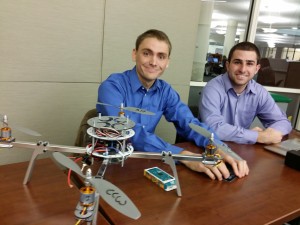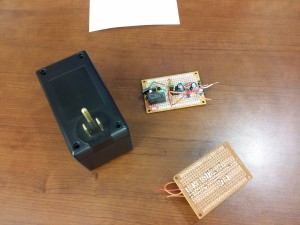Students share experiences with quadcopters, circuitry at February’s Maker Meetup

Jake Smith (left) and Alex Simoneaux (right) share their experiences with making at February’s Maker Meetup.
Makerspaces, quadcopters and circuitry that syncs lighting to music: it sounds very futuristic. But this is exactly what engineering professor Dr. Scott Wolter and two of his students, juniors Jake Smith and Alex Simoneaux, have been working on here at Elon. Through Teaching and Learning Technologies’ first Maker Meetup, the team presented their work in these areas and what they’ve learned through making as well as opened the conversation for other maker projects.
Using quadcopters
During Fall 2014, Smith and Simoneaux took research methods with Dr. Wolter, during which they were exposed to a number of different maker projects. One of those was the quadcopter. A quadcopter is a miniature helicopter that is lifted and propelled by four rotors.
Though they were intrigued by its capabilities, they admit that building the quadcopter was far from easy.
“We bought this kit and all the parts came in its,” Smith said. “When you get parts, [you assume you’ll get] instructions. That doesn’t exist for this [project]. We used the Internet, but the Internet is big and people say things that are not true. We had to do research and figure out which information to listen to.”
Some of the first test runs with the quadcopter ended with dramatic crashes. Smith and Simoneaux realized that with the quadcopter’s original operating system, their control over it was limited. So, with the help of Dr. Wolter, they purchased Arduino, which allowed them to take control of the copter through their own coding.
“We got Arduino to code it,” Smith said. “It will give us what we need to fly this copter ourselves and allow for more functionality.”
Smith cited MIT, who is using quadcopters to give tours on campus, as an inspiration for what the quadcopter can do. They mentioned how they would ultimately like to try to program a quadcopter to deliver a pizza to pre-determined coordinates.
MORE: Read how the ATACC grant helped Dr. Wolter and other professors implement technology to advance student learning
The LiveLight project
The quadcopters aren’t the only experience Smith and Simoneaux had with making. They have also working an invention of their own creation, LiveLight, an outlet plug-in that utilizes advance circuitry to sync music with lighting.
“We have a lot of lights in our dorm room, so we wanted to make them flash to our music,” Simoneaux said. “Then, we took a class with Dr. Wolter and the circuitry [we learned from him] advanced the project.”
LiveLight can plug into any standard outlet, and from there, a user can plug a set of lights into the top and bottom outlet. When a song is played, the top set of lights will blink to the melody while the bottom will blink to the bass.
While they consider creating LiveLight a valuable experience, Smith and Simoneaux credit their general studies course, Entrepreneurship in the Arts (GST 321), for bringing their project to a new level.
“In Entrepreneurship in the Arts, we took our product and learned the business aspects about it,” Simoneaux said. “We learned to market our product and who its target markets was. For a project that started out of purely scientific, we now have a well-rounded feel for what we’re trying to do.”
Even the name LiveLight was generated through the class. Simoneaux and Smith hope to one day bring their project to their target audience: college students.
During their presentation of LiveLight at the meetup, other attendees offered suggestions on how to improve the design that Simoneaux and Smith are seriously considering the product’s next iteration.
Learning from making
With both projects, Smith and Simoneaux found that despite the challenges, making was more rewarding and fun than they expected it to be. But they understand some people’s hesitation to jump into a maker project.
“We found that people don’t get into makers projects because it’s intimidating,” Smith said. “[Projects like] quadcopters are awesome, but intimidating. It’s a complex thing made of a lot of simple parts. With anything that is difficult, you just need to take it apart and learn the small parts.”
Both Smith and Simoneaux expressed that their experiences making something have taught them management skills and gave them opportunities to apply in-class concepts to real world experiences. Most of all, they realized that making means messing up and how that can be the best way to learn.
“Failure is an option,” Smith said. “It’s going to happen and then it’s going to happen again. You have to learn from it. If you really want to learn, break something and put it back together. Then, you’ll really know how that thing works.”
If you’re interested in getting involved with making on campus, check out the list of upcoming maker-inspired events and workshops.

 Follow
Follow


I just wanted to mention that your article about Alex’ and Jake’s work was well-done!